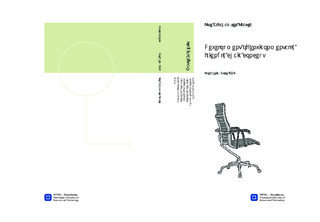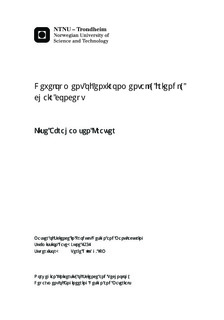| dc.contributor.advisor | Rølvåg, Terje | nb_NO |
| dc.contributor.author | Kratter, Lise Abrahamsen | nb_NO |
| dc.date.accessioned | 2014-12-19T12:27:45Z | |
| dc.date.available | 2014-12-19T12:27:45Z | |
| dc.date.created | 2012-11-08 | nb_NO |
| dc.date.issued | 2012 | nb_NO |
| dc.identifier | 565980 | nb_NO |
| dc.identifier | ntnudaim:8210 | nb_NO |
| dc.identifier.uri | http://hdl.handle.net/11250/241583 | |
| dc.description.abstract | The governing purpose of the thesis is to develop a chair concept based on a tilting mechanism called VAPAC. This chair concept has many potential ergonomic and environmental benefits that should be included and developed in the design. The report starts with an analysis of different segments within the chair market. Based on an evaluation, office chairs was chosen as the segment for the VAPA-Chair. Due to an interesting tilting idea suggested by the Supervisor/Concept originator, a test rig was built in order to try out a chair concept using straps for the tilting mechanism. This assignment was not originally one of the main tasks in the problem definition of this thesis . Due to curiosity and expectations for the idea, it was chosen to include this assignment in the thesis. A user survey reviled that this tilting idea offered an exciting and comfortable sitting experience. The concept using straps as tilting stringers was therefore developed further and important lengths and angles regarding the tilting mechanisms were settled. A problem occurred due to the risk of the chair tilting completely around if the user leans too much forwards or backwards in the chair. Making the stringers stiff so that they can withstand pressure when introduced to a load solved this problem. The tilting function was still the same as with the regular straps because the stringers were attached in joints, allowing the stiff straps to rotate freely. An Idea using turnbuckles as stringer was developed. This solution ensured the required stiffness as well as possibilities for height adjustment and a stop mechanism for the tilting. The terms Ergonomic and Environmental friendly is introduced, and important elements from these was set as requirements for the chair concept. Design sketches, doodling and brainstorming generated ideas for different concepts. Different functional concepts was introduced and evaluated as sub-parts of the chair. One concept was chosen for each part resulting in a holistic concept for the chair.The preliminary work results in a final concept, which is presented in the form of hand sketches and a 3D model using the program NX 7.5 Mechatronics . A lot of time was spent on modeling a simple and functional design with ergonomic and environmental friendly solutions.A material analysis was conducted regarding the bearing structure of the chair using the Life cycle analysis tool Eco-indicator 99. The analysis compared aluminum and steel. Due to low environmental impact using recycled aluminum, this material was chosen for the VAPA-Chair. A life cycle analysis was also conducted on the chair using the program CES Edupack. The analysis showed that the part of the chair s lifecycle that impacts the environment the most, is the production of materials. Based on these results, it is recommended that the VAPA-Chair should focus on weight optimization of the chair and use as much recycled aluminum as possible in the production. Based on results from the report, a list of recommendations for further work is presented. | nb_NO |
| dc.language | eng | nb_NO |
| dc.publisher | Institutt for produktutvikling og materialer | nb_NO |
| dc.subject | ntnudaim:8210 | no_NO |
| dc.subject | MTPROD produktutvikling og produksjon | no_NO |
| dc.subject | Produktutvikling og materialer | no_NO |
| dc.title | Development of environmentally friendly chair concept | nb_NO |
| dc.type | Master thesis | nb_NO |
| dc.source.pagenumber | 98 | nb_NO |
| dc.contributor.department | Norges teknisk-naturvitenskapelige universitet, Fakultet for ingeniørvitenskap og teknologi, Institutt for produktutvikling og materialer | nb_NO |

